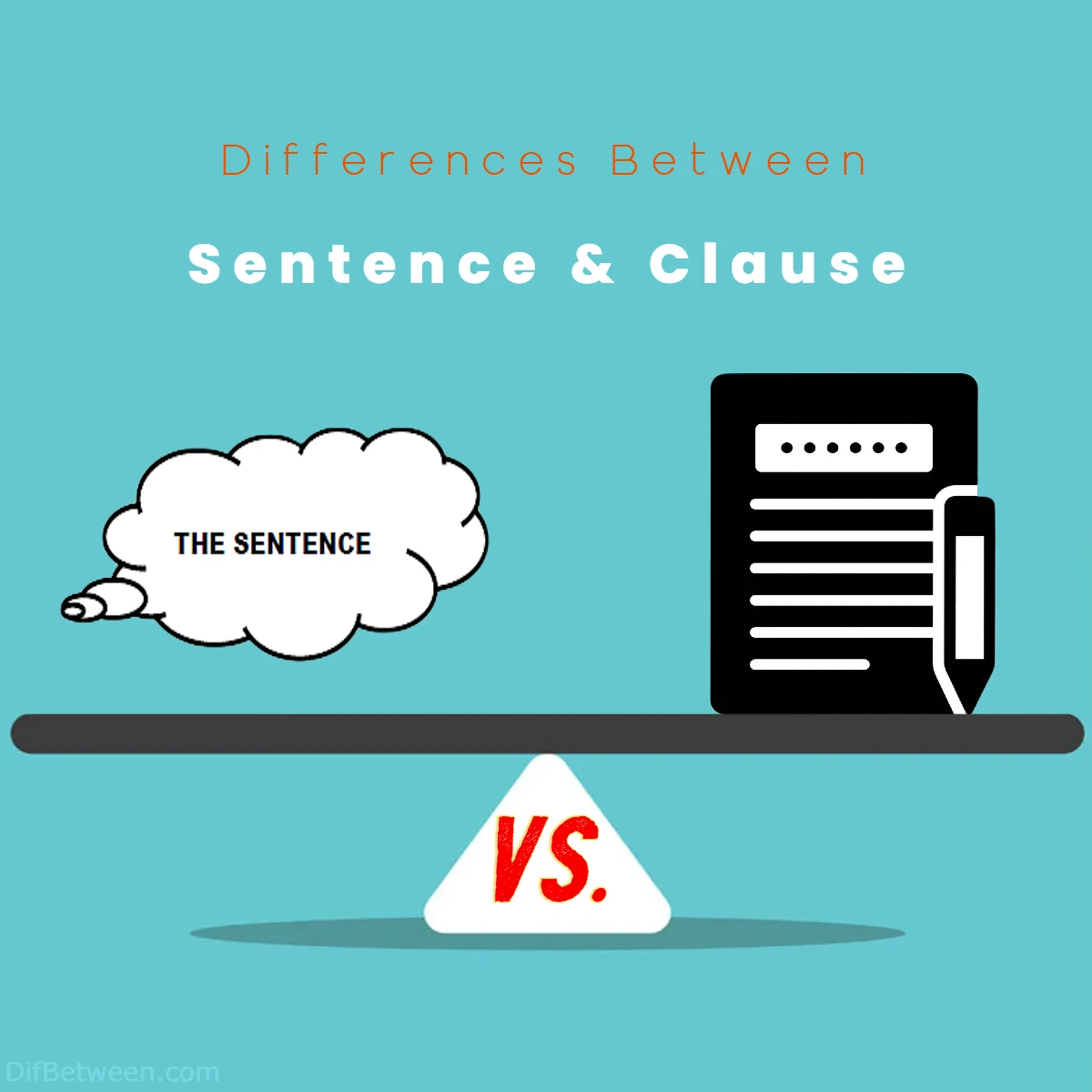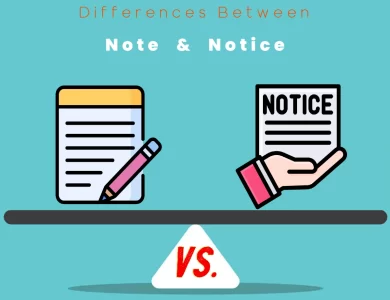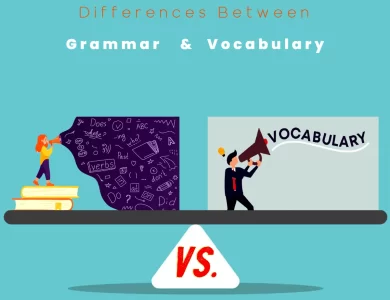
| Aspect | Sentence | Clause |
|---|---|---|
| Definition | A grammatical unit expressing a complete thought or idea. | A group of words containing a subject and a predicate. |
| Independence | Can stand alone as a complete thought. | May or may not be able to stand alone as a complete thought. |
| Components | Comprises a subject and a predicate. | Also comprises a subject and a predicate. |
| Types | Simple, complex, compound. | Independent and dependent. |
| Structure | May consist of one or more clauses. | Always contains a subject and a verb. |
| Functions | Conveys complete thoughts or ideas. | Adds context, detail, or conditions to sentences. |
| Punctuation | Begins with a capital letter and ends with a punctuation mark. | Punctuated based on its position within a sentence. |
| Examples | – Simple: “She sings.”<br>- Complex: “Although it rained, they went for a walk.”<br>- Compound: “He studied hard, and he aced the exam.” | – Independent: “They danced all night.”<br>- Dependent (Adjective Clause): “The book that she recommended is excellent.”<br>- Dependent (Adverbial Clause): “Since he finished his work early, he decided to go for a walk.” |
| Common Mistakes | Sentence fragments, comma splices. | N/A |
| Role in Communication | Primary conveyors of complete thoughts or ideas. | Enhance sentences by providing context or detail. |
| Practical Applications | Writing, reading comprehension, effective communication, grammar and proofreading. | Writing, sentence structure analysis, understanding complex sentences. |
In the realm of language, sentences stand tall as the architects of complete thoughts and ideas. They are the robust conveyors of information, encapsulating our statements, questions, commands, and exclamations. But what about the unsung heroes, the clauses? They may not steal the spotlight, yet they play a pivotal role in shaping the intricacies of our sentences. Clauses, both independent and dependent, add layers of context, detail, and complexity, elevating our communication to new heights.
Differences Between Sentence and Clause
The main differences between sentences and clauses lie in their structure and function. A sentence is a complete grammatical unit expressing a thought or idea and can stand alone as a complete statement. In contrast, a clause is a group of words containing a subject and a verb but may not always convey a complete thought on its own. Clauses can be independent, functioning as standalone sentences, or dependent, providing additional context or information within a sentence. Understanding these distinctions is essential for effective communication and grammatical accuracy.
The Basics: Sentences and Clauses Defined
Sentences are the fundamental units of communication. They express complete thoughts and often consist of one or more clauses, each with its own specific function within the sentence. To better understand the differences, let’s start by defining these two linguistic entities.
Sentences
A sentence is a grammatical unit consisting of one or more words that convey a complete idea. It typically includes a subject (who or what the sentence is about) and a predicate (what the subject is doing or the information about it). Sentences are the main vehicles for expressing thoughts, questions, commands, or exclamations.
Clauses
On the other hand, a clause is a group of words within a sentence that contains a subject and a verb. Clauses can be classified into two primary types: independent clauses and dependent clauses.
- Independent Clauses: These are complete thoughts that can stand alone as sentences. They express a complete idea and do not rely on other clauses to make sense.
- Dependent Clauses: These are incomplete thoughts that cannot stand alone as sentences. They rely on independent clauses to form complete sentences. Dependent clauses often function as adverbs, adjectives, or nouns within a sentence.
Now that we have the basic definitions, let’s delve into the key differences between sentences and clauses in more detail.
Structure: Sentences vs. Clauses
One of the primary distinctions between sentences and clauses lies in their structure.
Sentence Structure
Sentences are typically structured with one or more clauses. A simple sentence consists of a single independent clause. For example, “She sings.” This sentence conveys a complete idea with a subject (“She”) and a predicate (“sings”).
Complex sentences, on the other hand, contain one independent clause and one or more dependent clauses. For instance, “Although it rained, they went for a walk.” In this complex sentence, “Although it rained” is the dependent clause, and “they went for a walk” is the independent clause.
Compound sentences feature two or more independent clauses joined by coordinating conjunctions such as “and,” “but,” “or,” and “so.” For instance, “He studied hard, and he aced the exam.” Here, “He studied hard” and “he aced the exam” are both independent clauses.
Clause Structure
Clauses, as mentioned earlier, are smaller units within sentences. They have their own structures and functions.
Independent Clauses
- Structure: Independent clauses have a subject and a predicate and can stand alone as complete sentences.
- Function: They express complete thoughts or ideas.
- Example: “She danced gracefully.”
Dependent Clauses
- Structure: Dependent clauses also have a subject and a predicate but cannot stand alone as complete sentences.
- Function: They add extra information to independent clauses, often functioning as adverbs, adjectives, or nouns.
- Example: “Because she practiced diligently,” in the sentence “Because she practiced diligently, she won the competition.”
Punctuation and Coordination
Another significant difference between sentences and clauses is the way they are punctuated and coordinated.
Punctuation in Sentences
In standard written English, a sentence is typically punctuated with a capital letter at the beginning and a punctuation mark (usually a period, question mark, or exclamation point) at the end. This punctuation indicates the boundary of a complete thought or idea.
Examples:
- “He loves to read.”
- “Did you finish your homework?”
- “What a beautiful sunset!”
Punctuation in Clauses
Clauses within sentences are also punctuated, but they follow different rules.
Independent Clauses
Independent clauses can be punctuated as standalone sentences if they are not connected to other clauses. When they are part of a larger sentence, they are usually separated by a comma and a coordinating conjunction (e.g., and, but, or).
Examples:
- “She loves swimming, and she often goes to the pool.”
- “I wanted to visit the museum, but it was closed.”
Dependent Clauses
Dependent clauses are usually set off by commas when they appear at the beginning of a sentence. If they appear at the end of a sentence, they typically do not require a comma.
Examples:
- “Because it was raining, they decided to stay home.”
- “They decided to stay home because it was raining.”
Common Mistakes to Avoid
Understanding the distinctions between sentences and clauses can help us avoid common grammatical errors. Here are a few mistakes to be aware of:
Sentence Fragments
A sentence fragment is an incomplete sentence that lacks either a subject, a predicate, or both. It may be missing essential information, making it confusing or unclear.
Example of a fragment:
- “Running late for the meeting.”
This sentence lacks a subject and does not convey a complete thought. To make it a complete sentence, you could say, “I’m running late for the meeting.”
Comma Splices
A comma splice occurs when two independent clauses are joined together with just a comma, without a coordinating conjunction or appropriate punctuation.
Example of a comma splice:
- “She loves to travel, she has visited many countries.”
To correct this, you can use a semicolon or add a coordinating conjunction:
- “She loves to travel; she has visited many countries.”
- “She loves to travel, and she has visited many countries.”
Functions of Sentences and Clauses
Sentences: The Power of Communication
Sentences are the primary conveyors of information and meaning in written and spoken language. They serve various functions in communication:
1. Stating Facts and Information
Sentences are used to present facts, share information, and provide descriptions. Whether you’re discussing historical events, scientific discoveries, or everyday observations, sentences are your go-to tool for straightforward communication.
Example: “The Earth orbits the Sun.”
2. Asking Questions
Questions are a crucial part of conversation and inquiry. Sentences allow us to pose questions that elicit responses and engage in dialogue.
Example: “What time is the meeting?”
3. Expressing Commands and Instructions
When you want to give directions, make requests, or issue commands, sentences provide the structure to convey your intentions clearly.
Example: “Please pass the salt.”
4. Conveying Emotions and Feelings
Sentences enable us to express our emotions, from joy and excitement to sadness and frustration. They allow us to connect with others on an emotional level.
Example: “I can’t believe we won the game!”
Clauses: Building Blocks of Meaning
Clauses, both independent and dependent, contribute to the complexity and depth of sentences. Here’s how they function within sentences:
1. Adding Context and Detail
Dependent clauses enhance sentences by providing context or additional details. They answer questions such as “why,” “when,” “where,” or “how,” enriching the narrative.
Example: “Although it was pouring rain, they decided to go for a hike.”
In this sentence, the dependent clause “Although it was pouring rain” offers context for their decision to go for a hike.
2. Creating Complex Sentences
Clauses enable us to construct complex sentences that convey layered ideas and relationships between different pieces of information.
Example: “She decided to take a break, even though she had a busy schedule.”
In this complex sentence, there are two clauses: “She decided to take a break” (independent) and “even though she had a busy schedule” (dependent).
3. Clarifying Relationships
Clauses help clarify relationships between ideas, actions, or conditions in a sentence. They provide the “glue” that holds sentences together.
Example: “He will study diligently to pass the exam.”
In this sentence, the dependent clause “to pass the exam” clarifies the purpose of his diligent studying.
Sentence vs. Clause Examples
To further illustrate the differences between sentences and clauses, let’s examine examples of both.
Sentence Examples
- Simple Sentence: “She dances.”
- This is a simple sentence with one independent clause that conveys a complete thought.
- Complex Sentence: “While they were at the beach, they built a sandcastle.”
- This is a complex sentence with one independent clause (“they built a sandcastle”) and one dependent clause (“While they were at the beach”) that adds context.
- Compound Sentence: “She enjoys reading, and he prefers watching movies.”
- This is a compound sentence with two independent clauses (“She enjoys reading” and “he prefers watching movies”) joined by the coordinating conjunction “and.”
Clause Examples
- Independent Clause: “They danced all night.”
- This is an independent clause that can stand alone as a complete sentence.
- Dependent Clause (Adjective Clause): “The book that she recommended is excellent.”
- In this sentence, the dependent clause “that she recommended” functions as an adjective, describing the book.
- Dependent Clause (Adverbial Clause): “Since he finished his work early, he decided to go for a walk.”
- The dependent clause “Since he finished his work early” functions as an adverb, providing the reason for his decision to go for a walk.
Practical Applications
Understanding the distinctions between sentences and clauses is not just a matter of grammar; it has practical applications in writing, editing, and effective communication.
Writing and Editing
When you write, being aware of the structure of sentences and the role of clauses allows you to craft more precise and engaging prose. You can use clauses strategically to add depth, context, and variety to your sentences.
Reading Comprehension
When you read, recognizing sentence and clause structures helps you understand the author’s intent and follow complex ideas. It allows you to dissect sentences and identify key pieces of information.
Effective Communication
In everyday conversations, knowing how to construct clear sentences and use clauses effectively can make you a more persuasive and articulate communicator. You can convey your ideas with greater precision and influence.
Grammar and Proofreading
When proofreading your writing or someone else’s, understanding sentence and clause structures helps you spot errors like sentence fragments, comma splices, and run-on sentences. This enhances the overall quality of your writing.
In conclusion, sentences and clauses are the building blocks of language, each with its unique role and function. By mastering their distinctions and harnessing their power, you can become a more effective communicator and writer, conveying your thoughts and ideas with clarity and impact. So, whether you’re crafting a compelling essay, engaging in a meaningful conversation, or simply expressing yourself in writing, remember that sentences and clauses are your allies in the world of language.
FAQs
A sentence is a grammatical unit that expresses a complete thought or idea. It typically includes a subject and a predicate and can stand alone as a complete statement.
A clause is a group of words that contains a subject and a verb. It can be either independent, capable of standing alone as a complete sentence, or dependent, requiring support from an independent clause to form a complete thought.
There are three primary types of sentences: simple (consisting of a single independent clause), complex (containing one independent clause and one or more dependent clauses), and compound (featuring two or more independent clauses).
An independent clause can stand alone as a complete sentence, expressing a full thought. In contrast, a dependent clause cannot function independently and relies on an independent clause to form a complete idea.
Clauses, especially dependent clauses, add depth, context, and detail to sentences. They provide answers to questions like “why,” “when,” “where,” or “how,” enriching the overall meaning of a sentence.
Sentences begin with a capital letter and end with a punctuation mark, such as a period, question mark, or exclamation point. Clauses within sentences are punctuated based on their position and role within the sentence, often using commas or conjunctions.
Understanding these differences is crucial for effective communication and proper grammar usage. It helps in constructing clear, well-structured sentences and avoiding common errors like sentence fragments or comma splices.
Certainly! A simple sentence example is “She sings.” An example of an independent clause is “They danced all night,” while a dependent clause example is “Because it was raining.”
Sentences are the primary means of conveying complete thoughts or ideas, while clauses enhance sentences by adding context, detail, and complexity. Mastering their distinctions improves writing and communication skills.
You can explore comprehensive resources on grammar and language in books, online grammar guides, or language courses to deepen your understanding of sentences and clauses.
Read More:
Contents






